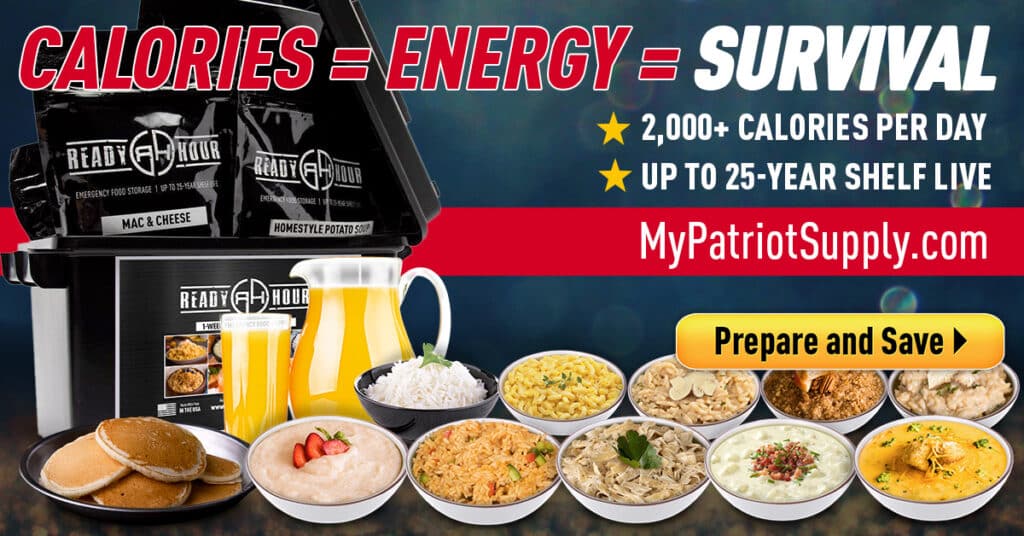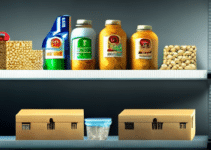Aside from survival food and water supplies, there are other essential items, such as emergency food and long-term food storage, that you should include in your emergency preparedness kit. These include a first aid kit, flashlights, batteries, a portable radio, a multi-tool, and a supply of prescription medications if needed.
Consider having important documents such as identification papers, insurance documents, and emergency contact information in a secure and easily accessible place.
Remember, being prepared for emergencies is not just about having the right supplies, but also having a plan in place
Click here to learn more about: ‘ patriot
How to Store Emergency Food
When it comes to ensuring the longevity of your emergency food supply, proper storage of longterm water storage is essential. You should pay attention to where and how you store your food to keep it fresh and edible for an extended period.
It is recommended to choose a cool, dry, and dark place, avoiding areas that are prone to temperature fluctuations.
To prevent moisture and pests from entering, it is best to use airtight containers or Mylar bags with oxygen absorbers.
Remember to label each container with the contents and date of storage for easy rotation. You should consider long-term water storage options.
Stocking up on at least one gallon of water per person per day is recommended. By following these guidelines, you can have peace of mind knowing your emergency rations are properly stored alongside your long-term water storage, ensuring maximum preparedness in case of an emergency.
Water Storage
When it comes to storing water, it is essential to consider the amount you need for emergency water supplies. Experts recommend having at least one gallon of water per person per day.
This includes drinking, cooking, and sanitation needs.
The recommended quantity takes into account various factors such as climate, age, level of physical activity, and overall health.
By having a sufficient water supply, you can be well-prepared for emergencies and have the assurance of having enough water to sustain your family during challenging times
Storing Water for Emergencies
- Having one gallon of water per person per day is recommended by experts for emergency water supplies.
- The recommended quantity takes into account various factors such as climate, age, level of physical activity, and overall health.
- Storing enough water can help you be well-prepared for emergencies and ensure the sustainability of your family during challenging times.
- Water is essential for drinking, cooking, and sanitation needs, making it crucial to have a sufficient supply.
Water Storage Planning for Emergency Preparedness Food
When it comes to ensuring the availability of food during times of crisis, emergency food storage becomes a crucial aspect of emergency preparedness. To effectively plan for water storage, there are several key considerations to keep in mind.
First and foremost, it is important to determine the amount of water required for survival.
On average, a person needs about one gallon of water per day for drinking and sanitation purposes.
By calculating the number of days you need to prepare for and multiplying it by the number of people in your household, you can determine the required water storage capacity.
In addition to calculating the necessary volume of water, the choice of containers for water storage is also crucial.
It is recommended to use food-grade containers
Water What to Include for Food
Water conservation is crucial not only for the environment but also for ensuring a sufficient supply of clean water for food preparation in disaster preparedness and the storage of emergency food and water supplies. Sustainable water management practices help alleviate the impact of water scarcity on food production and maintain the quality of water used for cooking and cleaning.
Emergency preparedness should include survival food and water kits, which are vital during crises.
By considering these measures, we can contribute to a more secure and sustainable food system for all
Water Conservation and Emergency Preparedness
- Water conservation helps protect the environment and ensures a sustainable supply of clean water for various purposes, including food preparation during disasters.
- Sustainable water management practices can mitigate the impact of water scarcity on food production and maintain the quality of water used for cooking and cleaning.
- Emergency preparedness should include survival food and water kits, which are essential for providing necessary sustenance during crises.
- Implementing these measures contributes to a more secure and sustainable food system for all, promoting resilience in the face of emergencies.
Water in Survival Kits The Best Containers for Emergency Food
In addition to the options mentioned above, another reliable choice for storing emergency food is the BPA-free plastic water jug, which is ideal for emergency food storage containers. These jugs can hold a substantial amount of water and come with a secure screw-on lid to prevent leaks and contamination.
They are also stackable, which makes storing and organizing them in survival kits easy.
These water jugs are often transparent, allowing users to monitor the water level without having to open the container.
This feature is crucial in emergency situations where the water supply may be limited, as it enables effective rationing of emergency food and water
Water Storage Tips for Creating a Survival Food
Store your water in a cool, dark, and dry place: Proper storage conditions are essential to maintain the quality and safety of your emergency water rations. Choose a location away from direct sunlight and extreme temperatures to prevent bacterial growth and the breakdown of containers.
Consider using water purification methods: While stored water may remain safe for consumption, it is always a good idea to have water purification methods on hand.
This can include water filters, purifying tablets, or boiling water to ensure its drinkability.
Calculate your water needs: It is important to determine how much water you will need for your survival food supply. The general rule of thumb is to store at least one gallon of water per person per day for drinking and sanitation purposes. Label your containers: To ensure the safety and organization of your emergency supplies, make sure to clearly mark them with the contents, including survival food rations, survival water rations, and emergency food and water rations.
Proper Water Storage
- Storing water in a cool, dark, and dry place prevents bacterial growth and container breakdown.
- Direct sunlight and extreme temperatures can negatively affect the quality and safety of stored water.
- Using water purification methods like filters, tablets, or boiling ensures the drinkability of stored water.
- It is recommended to store at least one gallon of water per person per day for drinking and sanitation purposes.
Water Plan Solutions for Storing Food
When it comes to preparing for emergencies or survival situations, it is crucial to have a well-thought-out water plan in place, which includes emergency food and water storage supplies. This is especially important when storing food because without access to clean water, your emergency supplies would be rendered useless.
To ensure the longevity and safety of your stored food, there are several crucial points to consider
Water in Emergency Situations Key Techniques for Preserving Survival Food
In addition to methods for purifying water and storing food properly, meal planning is a crucial aspect of preserving survival food during emergency situations, which can be achieved through emergency food and water kits for survival. It is important to create complete sentences and avoid using more than one of the keywords: survival food, water supplies, and emergency preparedness, in this article.
By developing a well-thought-out meal plan, you can effectively utilize your food supplies and minimize waste.
Balanced meals that utilize available ingredients allow you to get the most out of your survival food and water supplies.
This not only meets your nutritional needs but also helps maintain morale and psychological well-being during challenging times. Therefore, when preparing for emergencies, do not forget to stock up on survival food and water supplies for emergencies.
Water Options for Stocking Up on Emergency Food
During emergencies, it is crucial to have reliable emergency food and water storage options to ensure the well-being of yourself and your loved ones. Along with stocking up on emergency food, considering your water options is equally important.
We will explore various ways to ensure an adequate water supply without explicitly mentioning survival food and water supplies.
We have already discussed options like bottled water, water filtration systems, water storage containers, and rainwater harvesting.
Now, let's delve into some additional solutions for emergency food and water storage that can help you be prepared for any unforeseen circumstances
Water The Role of Rations in Surviving Food
When it comes to surviving food scarcity, having access to water supplies is crucial for emergency preparedness, and one of the key ways to ensure this is by utilizing emergency food and water storage units. In emergency situations, the availability of safe drinking water becomes a primary concern.
Without enough water, it becomes difficult to nourish ourselves and maintain our well-being.
To ensure survival, it is important to establish a rationing system that provides enough water for drinking, cooking, and hygiene purposes.
It is crucial to address the quality of the available water by using purification techniques like boiling or water filters. Proper storage and preservation methods are also essential to prevent contamination and spoilage. By understanding and addressing these factors, individuals can better prepare themselves for emergencies through survival food and water storage systems.
Emergency Food and Water Storage
- Access to water supplies is crucial for emergency preparedness.
- In emergency situations, safe drinking water becomes a primary concern.
- Establishing a rationing system is important to provide enough water for drinking, cooking, and hygiene purposes.
- Purification techniques like boiling or water filters can help improve the quality of available water.
Water Crises
Water crises are a pressing global concern with significant implications for both developed and developing nations, highlighting the urgent need for implementing effective emergency food and water storage plans. These crises have multifaceted causes, including climate change, population growth, pollution, inefficient water management, and inadequate infrastructure.
These factors interplay and worsen the problem, leading to severe water scarcity.
The impacts of water crises are far-reaching, affecting human health, agriculture, ecosystems, and the economy.
Marginalized communities, women, and children are particularly vulnerable to these detrimental effects.
To address this issue, it is crucial to focus on water conservation and management.
Initiatives like rainwater harvesting, wastewater recycling, and efficient irrigation techniques can help in this regard. Access to clean water and sanitation facilities is vital. It requires infrastructure projects, improved water quality testing, and hygiene promotion alongside emergency food and water storage plans for comprehensive disaster preparedness.
Emergency Food Ensure Survival with Water Storage
Emergency Preparedness Essential Food and Water





